This was published 6 years ago
Beneath the bravery of our most decorated soldier
Victoria Cross recipient, Father of the Year, business leader and mental health advocate - Ben Roberts-Smith is one of Australia's most respected public figures. So why are so many questions being asked about his past?
By Nick McKenzie and David Wroe & Chris Masters
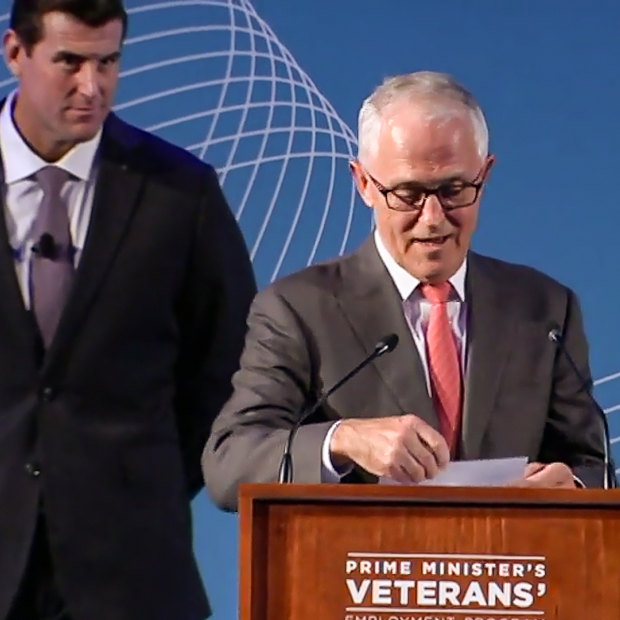
When Malcolm Turnbull gave a speech four months ago about the struggle some veterans faced readjusting to civilian life, it was hard to ignore the man towering behind him in the Great Hall of Parliament House.
Hands clasped and head slightly bowed, Australia's most decorated Afghanistan veteran, Ben Roberts-Smith, stood on stage with the Prime Minister as a living testament to success after the military.
Having received a Victoria Cross for bravery during an assault on the Afghan village of Tizak in 2010 – an award that was preceded by a Medal for Gallantry and followed by a Commendation for Distinguished Service – Roberts-Smith was in the midst of a seemingly successful transition into corporate life.
The transformation from battlefield to boardroom was significant. For 10 years, Roberts-Smith had served with Australia's Special Air Service Regiment, a unit of elite soldiers who are mostly not allowed to speak about their work.
Receiving the Commonwealth's ultimate bravery award made Roberts-Smith an instant celebrity. His agent began charging thousands to corporate clients to hear not only from "the most decorated soldier in the Commonwealth" but a man who had also been named "Australian Father of the Year".
He was appointed chairman of the Australia Day Council, the deputy chairman of the Prime Minister's defence mental health committee and veterans' employment committee. He became the public face of a campaign against "one punch" violence and the "Stay Kind" campaign, which urges Australians to look after vulnerable mates.
He helped select domestic violence campaigner Rosie Batty as an Australian of the Year. The award ceremony produced an evocative image of the 196-centimetre warrior gently comforting a tearful Batty.
The photograph fitted his public ethos, which was to value "moral courage" above physical prowess and "cherish your family every single day".
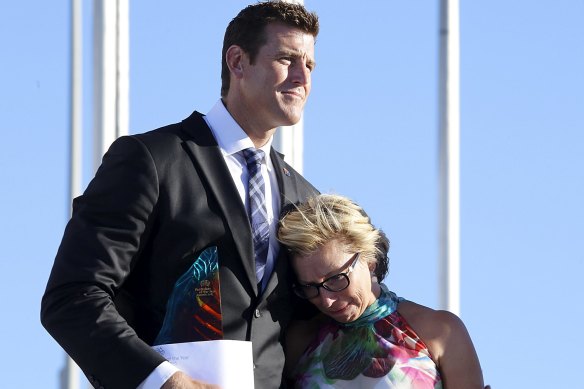
Rosie Batty, having just been announced as 2015 Australian of the Year, is comforted by Ben Roberts-Smith, Chair of the National Australia Day Council.Credit: David Flannery
But as he stood behind Turnbull at a veterans' function at Parliament House on March 28, serious doubts about his conduct were being discussed in senior defence circles.
Among the assembled generals and politicians in the Great Hall that night were some who had trouble reconciling disturbing allegations about Roberts-Smith's behaviour in Afghanistan and back home with the grand public image.
Over almost a year, Fairfax Media has interviewed dozens of veterans, officials and people with knowledge of Roberts-Smith's personal conduct including decorated soldiers who served alongside him. Their claims include bullying, intimidation and his involvement in small SAS teams suspected of the abuse of unarmed civilians and the use of force that goes well beyond what is acceptable in the theatre of war.
Indeed, some of the most important people in the room that night knew of the allegations.
At the VIP table sat the unflappable Chief of Army and special forces veteran, Lieutenant-General Angus Campbell. Two years earlier, Campbell had commissioned the Inspector-General of the Defence Force to begin an inquiry into the nation's special forces – the most penetrating inquiry in the recent history of Australia's military.
Disturbing rumours
By the time of the Great Hall event, it was clear to an inner circle in defence that disturbing rumours about small SAS patrol teams – typically consisting of five to six men including a patrol commander and deputy commander – involved serious allegations about their conduct in Afghanistan.
The patrols under scrutiny featured Roberts-Smith as a key player, either as a deputy or lead patrol commander. Those making the allegations were from the SAS itself and had served alongside Roberts-Smith's patrols in Afghanistan.
The allegations concerned the patrols' treatment of detainees or unarmed Afghans. They included claims that the patrols may have failed to report accurately incidents in which Afghans had been subjected to the use of force, including acts of brutality perpetrated against unarmed men.
SAS veterans have also alleged to Fairfax Media that Roberts-Smith bullied and intimidated fellow soldiers, including two junior operators who made internal complaints about the impact of his conduct on their mental health.
Witnesses allege one was punched in the head by an angry Roberts-Smith after a battlefield bungle.
But it wasn't only Roberts-Smith's conduct as an SAS operator that would prompt scrutiny. That evening at the Great Hall would result in further allegations that suggest he was struggling with the difficult task of living up to all that was expected of him.
Sitting on the same VIP table as Lieutenant-General Campbell, between ADF deputy chief Vice-Admiral Ray Griggs and Veterans' Affairs Minister Darren Chester, was a female lawyer whom Roberts-Smith had brought as his guest, and whom he'd introduced to military figures earlier that day as a client of his employer, Channel Seven.
After completing a masters of business administration in 2016, the former Australian Army corporal had been appointed general manager of the TV network's Queensland operations by media tycoon Kerry Stokes. But the woman wasn't a Channel Seven client. Instead, Roberts-Smith was in the midst of a extramarital relationship with the woman.
Sources at the event questioned why Roberts-Smith risked revealing that he was having an affair by taking his mistress to a high-profile function where, beyond the Prime Minister, he was the most prominent guest. But, far more concerningly, senior defence officials later learnt of allegations she raised with police about what happened later that night at the Hotel Realm in Canberra: an alleged act of domestic violence and intimidation.
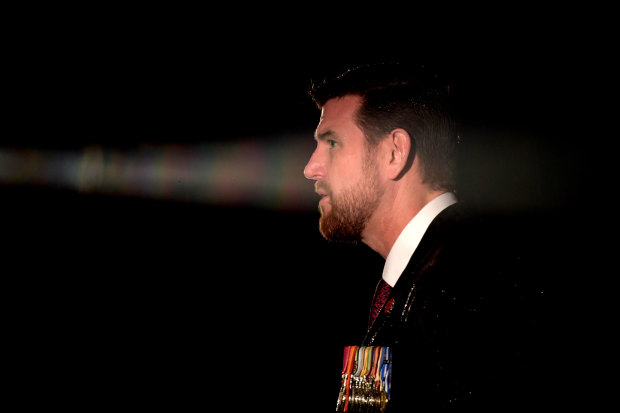
Roberts-Smith speaks on Anzac Day, 2017 in Melbourne.Credit: AAP
Through his lawyer, Roberts-Smith initially declined to respond to the allegations concerning his guest at the event.
He did not respond to questions about allegations being made separately by some of his former SAS colleagues and what knowledge, if any, he has about the mistreatment of Afghans.
Roberts-Smith is also silent on the question of whether he knows anything about who has been sending anonymous letters and emails to, or about, his accusers.
Risking all
Shortly after the guns fell silent at Tizak in 2010, the sneakers Ben Roberts-Smith wore during the famous battle were photographed. The white shoes are splattered with blood. They evoke the image of a man racing towards danger, risking all.
His Victoria Cross citation puts this image in words, describing an "extreme devotion to duty" paired with "a total disregard for his own safety" as Roberts-Smith "stormed the enemy position killing the … machine gunners".
During his deployments to Afghanistan in 2009 and 2010, Roberts-Smith was deputy commander of a small SAS patrol. In his last overseas deployment, prior to leaving the army in 2013, he was appointed patrol commander.
Fairfax Media has confirmed by speaking to multiple special forces insiders that among the allegations made to the Inspector-General's inquiry is that patrols he helped lead brutally mistreated unarmed Afghans.
RS [Roberts-Smith] repeatedly smashed this guy in the cheek and kneed him in the guts. I went, ‘Whoa whoa whoa. Back off mate.'
A defence force insider
Four defence insiders have alleged that they observed patrols under Roberts-Smith's direct or deputy leadership severely mistreat unarmed Afghans on four occasions.
A member of Roberts-Smith's 2009 patrol allegedly encouraged a more junior trooper to execute a detainee – a suspected militant – and was later overheard boasting about it. Fairfax Media has obtained a photo of the dead man and two witness accounts describing the circumstances in which the Afghan died.
One insider, an experienced SAS soldier, has vividly described intervening to stop Roberts-Smith bashing an unarmed Afghan whom two patrol commanders were seeking to arrest in 2010.
The bearded man had frozen in the foetal position when Roberts-Smith entered the room, wearing Kevlar gloves.
The insider describes Roberts-Smith unexpectedly attacking the man, pummelling him in the face with his fists, and in the stomach with his knees.
"RS [Roberts-Smith] repeatedly smashed this guy in the cheek and kneed him in the guts. I went, ‘Whoa whoa whoa. Back off mate. We have this under control.'
"The fella's face immediately blew up. We stepped back and gave the fella some space. We then arrested him."
Two alleged incidents have been separately recounted by other SAS members and involve men under the control of a patrol being led by Roberts-Smith. Both involve the alleged mistreatment of Afghan men who witnesses claim were posing no threat to Australian soldiers and could have been arrested without the use of force. One of the men harmed was in custody and posing no threat at all when he was allegedly badly assaulted.
Sources from inside the SAS say this alleged mistreatment was not only unnecessary but potentially counter-productive. An essential purpose of the Afghanistan mission was the protection of the local population and the generation of confidence in the coalition and government forces.
The sources also concede that, while the allegations caused deep concern, and were discussed informally and sometimes raised with more senior SAS soldiers, they were not immediately reported to senior command in Canberra.
A new career
Keeping secrets is part of being in the SAS. Yet by late 2012 and early 2013, as Roberts-Smith was preparing to embark on his new career as a corporate and community leader and mental health champion, some of his SAS colleagues were asking if the decorated warrior might have shirked scrutiny because less experienced soldiers were worried about challenging him.
Much of the concern held by senior military officers about the cultural problems within the SAS have involved keeping quiet about behaviours that needed confronting. A report in March 2016 by then Special Operations Commander Major-General Jeff Sengelman described a culture of impunity that may have normalised allegedly disturbing behaviour. Sengelman's report also identified serious "governance and behavioural lapses" and ultimately helped spark the Inspector-General's inquiry.
A record of a discussion between two long-serving SAS patrol commanders, obtained by Fairfax Media, reveals some experienced soldiers in the regiment were worried that Roberts-Smith's apparent bullying meant some in his patrol were scared to question battlefield incidents or those which allegedly occurred back at base or in training.
The two patrol commanders identify that the first time Roberts-Smith came to attention for alleged bullying inside the SAS was in 2006, during his first deployment to Afghanistan.
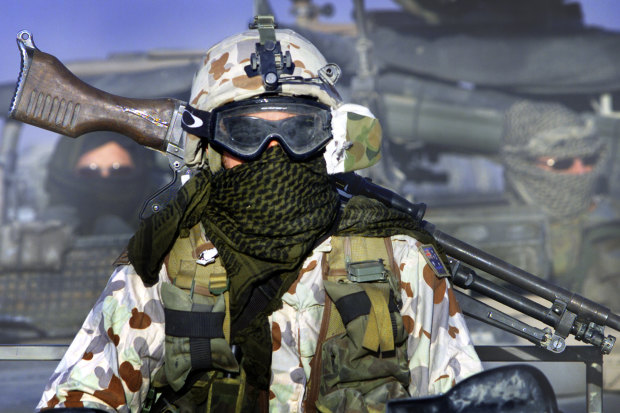
SAS soldiers on patrol in Afghanistan in 2005.Credit: Simon O'Dwyer
Following a hair-raising battle early in the deployment, Roberts-Smith fell out with two members of a six-man patrol, in part over whether it was necessary to kill an Afghan who had earlier walked past the patrol's observation post.
One of the two patrol members later insisted to colleagues the Afghan appeared to be an unarmed teenager whose death could have been avoided.
But it was a perilous circumstance and a tough call apparently made in the fog of war. Roberts-Smith's version of events was backed by other patrol members.
The young male was presumed to be a "spotter". This meant there was a chance he might have seen the observation post and planned to report it to the Taliban, who could then attack. Roberts-Smith and other patrol members also said the male was armed with a smoke grenade, which exploded after he was shot.
The conflicting accounts are mirrored in official reports relayed by the patrol to senior officers and seen by Fairfax Media. Some post-incident reports describe an anti-coalition militant posing a "threat." Some reports go further, falsely stating the dead male was armed with an automatic rifle.
Roberts-Smith accused the two patrol members critical of his actions of cowardice and failing to prepare their weapons.
Multiple sources contend Roberts-Smith followed up this critique with repeated bullying of the smaller and quieter of the two patrol members, Trooper M. (Fairfax Media cannot name a serving SAS soldier but have confirmed he is still serving and has been promoted to patrol commander)
More than one witness claims to have overheard Roberts-Smith threatening to harm Trooper M, an alleged threat Trooper M relayed to colleagues.
The two patrol commanders alleged "years of bullying that RS [Roberts-Smith] put him through" and which impacted his mental health. A bullying complaint against Roberts-Smith was ultimately lodged inside the SAS by Trooper M , which led to mediation.
Commended for leadership
Roberts-Smith's promotion to patrol commander left him responsible for mentoring junior soldiers under his command. It was an appointment he relished, a realisation of leadership ambitions. Some other SAS soldiers were also pleased, considering Roberts-Smith a fierce and impressive soldier now able to pass on his knowledge to less experienced operators.
But not all felt that way. Concerns inside the SAS about the treatment of the least-experienced member of Roberts-Smith's patrol, Trooper J, were raised in mid-2012, just prior to deployment to Afghanistan.
During a training exercise in Perth involving the mock capture of an Afghan prisoner, three SAS soldiers witnessed Roberts-Smith instruct Trooper J to shoot the detainee.
"RS grabbed [Trooper J] by the shoulder and said, ‘F--ing kill him, f--ing kill him'," an SAS soldier who claims to have witnessed the event said.
The soldier alleges Trooper J responded by half-heartedly simulating a mock execution ("he went ‘bang' as a joke," recalls a witness).
This witness alleges that Robert-Smith then said, "You good with that?" The witnesses who observed the order said that two patrol commanders informally challenged Roberts-Smith, telling him to "pull your head in".
After arriving in Afghanistan in July 2012, the mentoring of Trooper J generated further controversy when a mission on July 15 to the Chora Valley to flush out the Taliban turned ugly, and one patrol member was nearly shot by a second SAS patrol in a near fatal "friendly fire" bungle.
Trooper J wasn't responsible for the friendly fire but he was accused of breaching protocol by firing his weapon in response and not adhering to Roberts-Smith's orders. He was formally investigated, placed on administrative duties with another patrol and soon after left the army.
According to statements later submitted to senior defence officials, Roberts-Smith ran his own, off-the-books disciplinary process. Multiple witnesses allege that Roberts-Smith castigated the trooper in front of his patrol, ordering Trooper J to stand up and then punching him in the head.
A further threat from Roberts-Smith was allegedly made several months later: if the trooper's account about the incident and aftermath was not consistent with his version, Roberts-Smith would report him to the International Criminal Court at The Hague for firing in the vicinity of civilians.
The treatment of Trooper J by Roberts-Smith concerned several experienced patrol commanders, who were also troubled about other aspects of Roberts-Smith's mentoring and leadership in 2012. The most pressing issue being discussed among a small number of senior SAS soldiers involved his patrol's involvement in an alleged assault on an unarmed Afghan.
I’ve been under the microscope for the last six years and, you know what, my record is spotless.
Ben Roberts-Smith
Those with concerns were surprised and angered, therefore, when Defence in 2014 released a formal assessment of Roberts-Smith's 2012 service as it awarded him a Commendation for Distinguished Service, praising his exemplary "mentoring … of his patrol and less experienced members".
Three patrol commanders, who are still serving with the regiment and who have also been recognised for their service in Afghanistan, signed a complaint written by one of the trio, Sergeant L. The complaint urged senior officers to investigate Roberts-Smith's mentoring, leadership and treatment of Trooper J.
"As SAS soldiers, we are responsible for accurate reporting and honesty, in the field and in camp. This citation is a contradiction of those values," the complaint said.
For two years, the complaint went nowhere. But it is one of many documents handed to the Inspector-General.
Denials and accusations
For his part, Roberts-Smith traces the complaints about his behaviour to the awarding of the VC in 2011. His forceful, driven personality – one shared by many in the regiment – stoked resentment.
When queried about this last year, he said: "I am hard, I get that, but there is no one I beat up harder than myself. You are supposed to be better. If not, you should not be there. Because if you make a mistake, someone is going to die."
His supporters insist the allegations stem from envy, most particularly from disgruntled veterans. Roberts-Smith's defamation lawyer also blames sensationalist journalists for seeking to bring down a war hero through a "smear campaign".
Ross Coulthart – a former TV investigative journalist who is now a public relations consultant for a firm, Cato and Clegg – is working closely with Roberts-Smith and his lawyer on his own investigation into Fairfax Media's reporting.
Coulthart has interviewed SAS soldiers close to Roberts-Smith and is privately insisting to people linked to Channel Seven there is no evidence of any wrongdoing. However, he and the PR firm's Sue Cato have declined to share their findings. Publicly, Coulthart refuses even to say who he is working for.
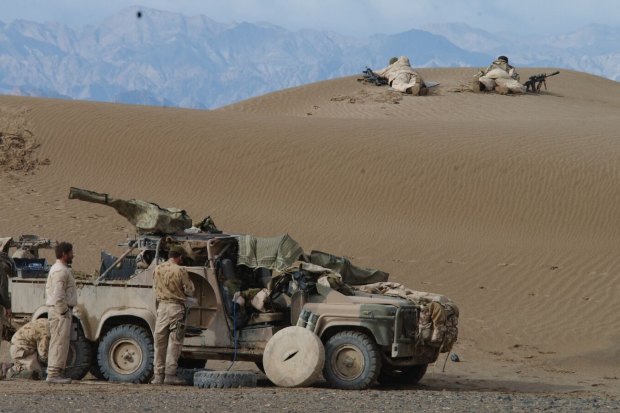
Australian SAS troops in Afghanistan.Credit: Forward Scout Films
Roberts-Smith has previously decried his critics as hypocrites, saying: "The bullying is what they do to me. Bullies are cowards. They stay in the shadows. This is about group cowardice. I don't like bullies. I am sick of it."
He has been unequivocal he has no questions to answer in respect of any of his actions in Afghanistan.
"I've been under the microscope for the last six years and, you know what, my record is spotless," he said in a newspaper interview when questions about his conduct in Afghanistan first emerged publicly in October 2017.
But the argument that critical accounts of Roberts-Smith amount to tall-poppy syndrome sits uneasily with the testimony of many who have served in the SAS, including in Afghanistan.
Some sources note that the reputations of that conflict's other Victoria Cross recipients Mark Donaldson and Dan Keighran (a VC was also awarded posthumously to Commando Corporal Cameron Baird) have faced no such challenges.
Most significantly, the allegations about Roberts-Smith and his patrols have, according to regiment sources, been made under oath before the Inspector-General – a step for those witnesses that is well beyond simply muttering darkly to colleagues and journalists.
Pushing back
Roberts-Smith has also been pushing back, apparently aiming to paint those making allegations about him as disgruntled liars.
In 2017, defamation lawyer Mark O'Brien, who is working for Roberts-Smith, separately wrote to the two soldiers who were members of Roberts-Smith's patrol in 2006 and who had expressed serious misgivings about his conduct.
The lawyer accused the two veterans of colluding to concoct false allegations.
Roberts-Smith sent a letter himself to a third SAS veteran, also threatening litigation.
The bullying is what they do to me ... This is about group cowardice. I don’t like bullies. I am sick of it.
Ben Roberts-Smith
Attention then shifted to a fourth SAS Afghanistan veteran, Sergeant L. He'd written the 2014 complaint that urged an investigation of Roberts-Smith's Commendation for Distinguished Service and which was signed by two other patrol commanders.
On October 18, 2017, in a letter sent to Fairfax Media, Roberts-Smith's defamation lawyer attacked the credibility of Sergeant L, accusing him of smuggling weapons into Afghanistan in 2012. (The two other patrol commanders who signed the 2014 complaint were not mentioned in the letter).
By now, more missives attacking Sergeant L were also circulating, although who was responsible for these remains a mystery.
On October 20, 2017, The Australian newspaper received an anonymous email. Fairfax Media has linked this email to a Queensland photographer, Nathan Richter but he has said he was just acting as a middleman and refuses to say who wrote and sent it.
This email repeated the historic gun smuggling claim and added some dramatic detail. It claimed Sergeant L was at grave risk of gunning down civilians in Perth. The baseless massacre allegation was also sent to Australian Federal Police in an apparent attempt to get police to raid Sergeant L. Days later, they did so, finding none of the weapons the mystery writer had promised would be located.
Six months later, another mysterious writer emerged.
In April, the female lawyer Roberts-Smith had weeks earlier taken as his guest to the Great Hall of Parliament House also received an email. It was from a "Danielle Kennedy" and claimed to have been sent on behalf of Roberts-Smith. By then, Canberra sources say the lawyer was alleging Roberts-Smith had subjected her to an act of domestic violence and intimidation in the hours after the Great Hall event in late March.
According to senior sources in Canberra, a relative of the woman complained about the alleged incident to a politician, who alerted a more senior colleague, who in turn alerted defence officials. Later, the alleged victim told police of her claims. Police have been told she had been drinking at the event, and as it ended, alleges Roberts-Smith appeared angry at her behaviour, worried it had exposed his affair to the military's top brass.
She stumbled and fell down some stairs at Parliament House as she left the event, causing further embarrassment. Police have been told that by the time the pair arrived back at the Realm Hotel, Roberts-Smith was allegedly furious and she was subjected to an act of domestic violence.
(Fairfax Media has decided not to name the lawyer due to the nature of her allegations. Defence and political figures who have been told of the allegations have said that once they learned she had gone to police, they took no further action.)
Police also have details of multiple phone and email accounts the married Roberts-Smith used to conduct the liaison prior to it ending on April 6, when the lawyer disclosed the affair to his wife.
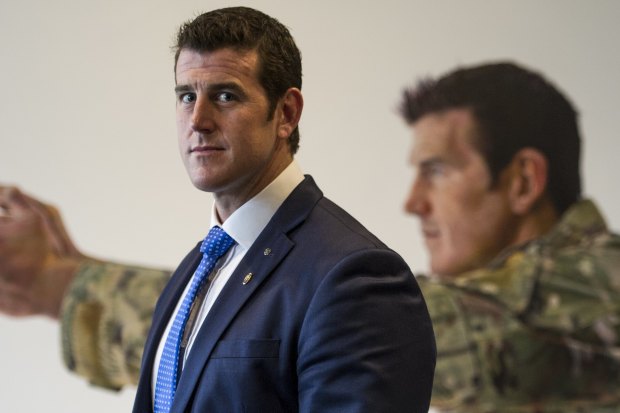
Ben Roberts-Smith in front of his portrait at the Australian War Memorial in Canberra.Credit: Jay Cronan
On April 22, the lawyer received the email from "Danielle Kennedy", who claimed to "represent Mr Roberts-Smith" and be acting on his "instructions." Fairfax Media could not locate any lawyer by the name of "Danielle Kennedy". The photo used in the email appears to have been stolen by someone from the internet. It is of Anne Whelford, an administrator at Lincoln University in Christchurch, New Zealand.
After a university spokesman was supplied by Fairfax Media with a copy of the "Danielle Kennedy" email, he sent a statement saying: "Lincoln University was unaware of the use of Anne Whelford's photograph, as was she, and neither party sanctions its use in this way".
The use of the picture "is a matter which should be dealt with by the police," the statement said.
The woman at the centre of allegations declined to comment. Roberts-Smith has also declined requests from Fairfax Media to be interviewed, or to answer questions about any knowledge he might have of "Danielle Kennedy", or why a stolen photo was used, or to give his version of events.
It is understood that after he received questions, he told his public relations advisers that no affair had ever occurred (a claim undermined by copious evidence) and that the alleged domestic violence and intimidation is also a malicious invention. And on Wednesday of this week – six days after he was alerted that Fairfax Media knew of the allegations reported to police as well as the mysterious "Danielle Kennedy" – Roberts-Smith contacted a Queensland police station, claiming to be a victim of stalking by the lawyer.
I am hard, I get that, but there is no one I beat up harder than myself
Ben Roberts-Smith
In respect of the claims made by SAS soldiers, Roberts-Smith has also privately dismissed allegations he is a bully or that he ever assaulted or bullied a fellow soldier.
Most significantly, Roberts-Smith privately and passionately dismisses all allegations he has ever breached the laws of armed conflict in Afghanistan. He recently retained a top Sydney barrister with expertise in military inquiries, Arthur Moses, SC.
In his recent public appearances, Roberts-Smith appears to have sought opportunities to burnish his image.
He recently appeared on a Channel Seven tourism and lifestyle program to highlight his family values – "family is the most valuable thing" – and his passion for supporting soldiers struggling with mental health problems.
Not a shred of evidence
In June, yet another mysterious letter writer was at work. A former member of Roberts-Smith's patrol received a letter from an anonymous source warning that he should withdraw what the letter described as false information given to the Inspector-General, or risk having adverse information about his own activities exposed.
The patrol member immediately reported the letter to the SAS Commanding Officer, who relayed it to the Inspector-General. The Inspector-General does not comment on ongoing investigations.
But the patrol member has told colleagues he is not scared by the threat.
Roberts-Smith's supporters privately insist the Inspector-General will clear him of any wrongdoing and there is not a "shred" of evidence that suggests otherwise. Roberts-Smith's supporters also say that the famous soldier is yet to give his version of events.
But SAS insiders aware of some of the adverse allegations about Roberts-Smith or the conduct of his patrols say credible evidence has already been placed on record and on oath.
Questions have dogged Ben Roberts-Smith from a time well before he became supersized by expectation, responsibility and pride in the spirit of the Anzacs. After two years of investigation, and having interviewed 200 witnesses on oath, the Inspector-General is expected to finalise his report in the coming months.
Roberts-Smith's response
On Friday Roberts-Smith released a statement via Seven West about this story. It read:
“The article contains a catalogue of lies, fabrications and misrepresentations. It is the culmination of many months of malicious and highly damaging allegations, all of which will be vigorously defended.
“I do want to say today that I unequivocally deny any physical abuse of any woman at any time ever, and that I have not at any stage been interviewed by Police about any purported complaint by any woman.
“I am deeply troubled that alleged evidence given on oath before the IGADF inquiry has been canvassed in the press and that Fairfax has allegedly accessed it. Not only is it illegal, it is unfair to people who haven’t given evidence and it has the potential to undermine the fairness of the inquiry.
“If and when I am given the opportunity to defend each specific allegation, I am very confident that direct witnesses will categorically demonstrate the falsity of them all.”
- Know more? Contact Nick McKenzie securely on this encrypted app.